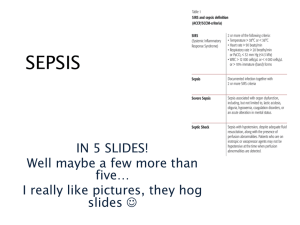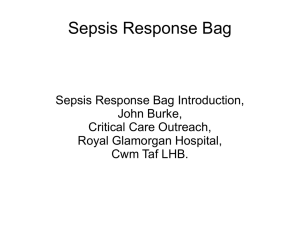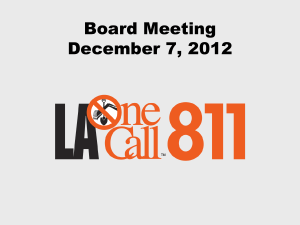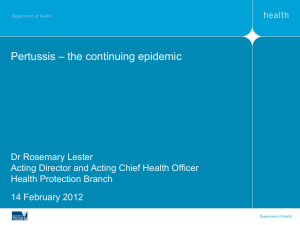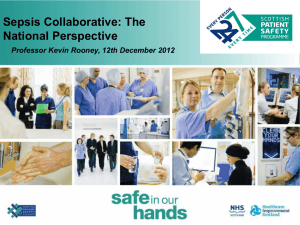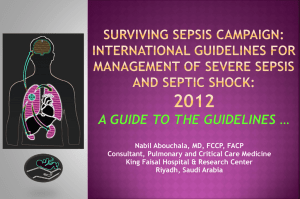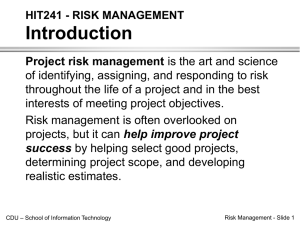PPT - Patient Safety Federation
advertisement
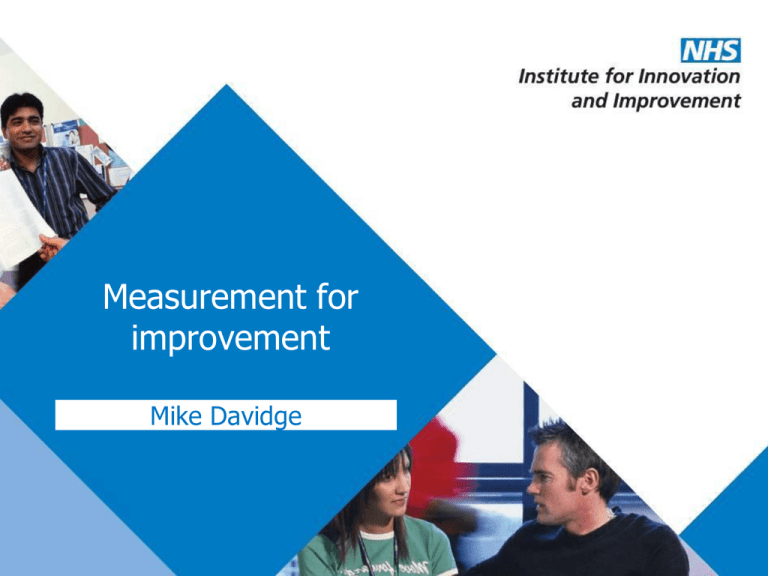
Measurement for improvement Mike Davidge 22 Measurement for improvement “Measurement is for improvement not judgement.” D. Berwick 3 Model for Improvement 4 7 Steps to measurement 1 Decide aim 2 Choose measures 3 Define measures 6 Review measures 7 Repeat steps 4-6 4 Collect data 5 Analyse & present 5 Measures checklist – a handy reminder Section 1 – – – – Rationale Definitions Data required Goals Section 2 – Collect – Analyse – Review 6 Clarifying aim is crucial 1 Decide aim 2 Choose measures 3 Define measures 6 Review measures 7 Repeat steps 4-6 4 Collect data Take the LIFT test. Would you be able to describe your aim in a couple of sentences? 5 Analyse & present Take 5 minutes to agree your aim 7 Choosing the right measures 1 Decide aim 2 Choose measures 3 Define measures 6 Review measures 7 Repeat steps 4-6 4 Collect data 5 Analyse & present 8 Types of measure Outcome measures – Reflect the impact on the patient – For example: unplanned return to ITU or crash calls. Process measures – Reflect the way you work – For example: % compliance with Sepsis 6 bundle. Balancing measures – reflect unintended consequences – For example: if you have implemented changes to reduce your post operative length of stay, you also want to know what is happening to your post operative readmission rate. If this has increased then you might want to question whether, on balance, you are right to continue with the changes or not. 9 2 Driver diagram AIM To improve recognition and timely management of patients identified with sepsis in ED and CDU by achieving 90% compliance with evidence based therapy (SEPSIS 6) by March 2013 SECONDARY DRIVERS PRIMARY DRIVERS 11 2 3 3 Early identification of patients with possible sepsis in ED, CDU and Wards Ensure sepsis best management practices in ED, CDU and wards Seamless transitions • Timely triage • Timely notification to, and assessment by nurse and doctor • Early and repeated lactate measurements • Monitoring and communication of progress • Early aggressive administration of IV fluids • IV antibiotics administered within 1 hour • Blood cultures taken before IV antibiotics are given • Education of staff in sepsis as time critical illness • Effective communication between ED , CDU and SCAS • Effective communication and transition with in-patient wards • Patient shadowing and information for patients 10 Choose your measures Use the driver diagram You have 5 minutes to customise to your system Now take another 5 minutes to decide which drivers and change ideas to measure Homework: Continue to discuss! AIM To improve recognition and timely management of patients identified with sepsis in ED and CDU by achieving 90% compliance with evidence based therapy (SEPSIS 6) by March 2013 SECONDARY DRIVERS PRIMARY DRIVERS 11 2 3 3 Early identification of patients with possible sepsis in ED, CDU and Wards Ensure sepsis best management practices in ED, CDU and wards Seamless transitions • Timely triage • Timely notification to, and assessment by nurse and doctor • Early and repeated lactate measurements • Monitoring and communication of progress • Early aggressive administration of IV fluids • IV antibiotics administered within 1 hour • Blood cultures taken before IV antibiotics are given • Education of staff in sepsis as time critical illness • Effective communication between ED , CDU and SCAS • Effective communication and transition with in-patient wards • Patient shadowing and information for patients 11 Definitions – an Achilles heel 1 Decide aim 2 Choose measures 3 Define measures 6 Review measures 7 Repeat steps 4-6 4 Collect data 5 Analyse & present 12 Collect 1 Decide aim Decisions, decisions What - All patients or a sample? 2 Choose measures Who – is collecting? 3 Define measures Where – is the data located? How – hospital system or audit? When – Real time or retrospective? 6 Review measures 7 Repeat steps 4-6 4 Collect data What is your baseline? 5 Analyse & present 13 14 Where to measure? Start ? Decision Point ? Handover ? End ? 14 It’s not an add-on Organise everything around value-added (front line) work processes W Edwards Deming All value-adding work is inherently local; All improvement is inherently local; therefore, As you implement a data collection system, You mustn't destroy clinical productivity Instead, you must Integrate data collection into workflow at the front line 15 Admission and Recognition Bundles Detail actions that should take place on a regular, routine basis such as: – – – – Observations Calculating and recording NEWS score Querying sepsis if the score is high Communicating NEWS and risk to whole team The aim is to embed these actions and behaviours into normal everyday practice So a high compliance with these bundles is demonstration that practice is based upon the best available evidence 16 Planning & testing your data collection What, Who, When, Where and How? You have 5 minutes to discuss your data collection plan And decide your first small test of change (PDSA) Homework: Run the PDSA 17 Analyse 1 Decide aim “The type of presentation you use has a crucial effect on how you react to data” 2 Choose measures 3 Define measures 6 Review measures 7 Repeat steps 4-6 4 Collect data 5 Analyse & present 18 How we traditionally assess performance: 2 point comparisons Last quarter 62 This quarter Change 66 +6% Why has the number of crash calls gone up? Our service is getting worse. We need to do something! What decision are you going to make? 19 What’s a person’s normal body temperature? 20 In the real world, everything varies.... How many patients did we admit today? How long does it take you to get to work? Is my temperature always the same? How long does it take to take a patients BP? 21 “Data contains both signal and noise. To be able to extract information, one must separate the signal from the noise within the data.” Walter Shewhart 22 There are two types of variation While every process displays variation: some processes display controlled variation (common cause) – Stable pattern of variation = noise – constant causes/ “chance” while others display uncontrolled variation – pattern changes over time = signal – special cause variation/“assignable” cause eg infection or hypothermia We should display data in a way that shows which is present 23 Revisiting Crash calls Last quarter 62 2006 2006 Jan Jan 3131 2012 2007 2007 Jan Jan 3232 This quarter Change 66 +6% 2011 Feb Feb 3636 Mar Mar 2727 Apr Apr 1818 May May 2222 Jun Jun 4040 Jul Jul 2323 Aug Aug 3131 Sep Sep 4242 Oct Oct 1919 Nov Nov 3131 Dec Dec 1616 Feb Feb 3232 Mar Mar 5454 Apr Apr 2222 May May 5151 Jun Jun 1717 Jul Jul 2424 Aug Aug 1111 Sep Sep 2727 Oct Oct 2424 Nov Nov 2626 Dec Dec 1616 24 As a run chart.. Complaints during 2006 to 2007 60 50 40 30 20 2006 Dec Nov Oct Sep Aug Jul Jun May Apr Mar Feb Jan Dec Nov Oct Sep Aug Jul Jun May Apr Mar Feb 0 Jan 10 2007 Number 25 • Plot data in time order • Calculate and display median as a line Run charts • Analyse chart by studying how values fall around median Complaints during 2006 to 2007 60 50 40 30 20 2006 2007 Dec Nov Oct Sep Aug Jul Jun May Apr Mar Feb Jan Dec Nov Oct Sep Aug Jul Jun May Apr Mar Feb 0 Jan 10 26 Percentage of sepsis patients that receive sepsis six with one hour NHH from Oct 2011 to Oct 2012 - All Wards 120 100 % compliance 80 60 40 20 10/09/20 12 10/08/20 12 10/07/20 12 10/06/20 12 Weeks 10/05/20 12 10/04/20 12 10/03/20 12 10/02/20 12 10/01/20 12 10/12/20 11 10/11/20 11 10/10/20 11 0 Data from an in hours Outreach service During this time sepsis was a major contributor to death in 15% of cases 27 Annotate your charts! 28 Review measures It is a waste of time collecting and analysing your data if you don't take action on the results 1 Decide aim 2 Choose measures Question 1 3 Define measures Where will the measures be reviewed? 6 Review measures 7 Repeat steps 4-6 5 Analyse & present 4 Collect data Question 2 When (how frequently) will we review them? 29 Where do you put stuff you want everyone to know? Why do we hide track and trigger scores at the foot of the bed and then audit them infrequently? 30 Insert name of presentation on 31 Putting Important Information In a Prominent Place Communicates to the whole team, all the time Quickly exposes where staff have difficulty with performing observations/calculating score Promotes education and training for possible eventualities 32 7 Steps to measurement You may not get it right first time! You may need several attempts to get it right for you 1 Decide aim 2 Choose measures 3 Define measures 6 Review measures 7 Repeat steps 4-6 4 Collect data 5 Analyse & present 33 Next steps – the project plan Measures 1 Decide aim – Do you have an agreed set of measures? If not, how and when will you get them agreed? 2 Choose measures Definitions – Who will complete measures checklists for all remaining measures and by when? 3 Define measures Review meetings – Have you agreed when you will review your measures? Set a date for the first meeting 6 Review measures 7 Repeat steps 4-6 Test your process 4 Collect data – When are you going to follow the 7 step process for your first measures? 5 Analyse & present 34 Thank you and here’s to effective measurement!
